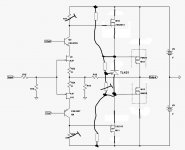Based on the plating used on that socket cap screw, it's pretty clear we're looking at a close cousin of BA-3. 🙂
--------------------------------------------From reading entire theme:
1. front end is common source, not output
2. from picture it is obvious that output is common drain
And a little of ideas for biasing
Thank you for your post.
I am sorry, but your circuit proposition and comments do not make any sense, specially in reference to the XA circuit description (XA manual).
Have you simulated it? What is the basis of your idea?
Last edited:
Why do you ask me did I simulate if you think this does not make any sense? 😀
No I didn't simulate this, not having intentions on building this amp, nor its iteration, just curiosity on used topology is driving me thinking of it 🙂
Don't think you did get wrong the image with output FETs - it must be common drain.
And, you posted this:
No I didn't simulate this, not having intentions on building this amp, nor its iteration, just curiosity on used topology is driving me thinking of it 🙂
Don't think you did get wrong the image with output FETs - it must be common drain.
And, you posted this:
Attachments
https://youtu.be/PpZMqCiD_Nw
however ... blurred part is still blurred
regarding original topology - not so hard to decipher for Papaland residents
though , as always with Papamps , Natura in minimis maxima ........
there is tricky part , instead of TL431** ......
**I know there are few FABs brave enough to sit on nitro , but I'm not so brave ...
however ... blurred part is still blurred

regarding original topology - not so hard to decipher for Papaland residents
though , as always with Papamps , Natura in minimis maxima ........
there is tricky part , instead of TL431** ......
**I know there are few FABs brave enough to sit on nitro , but I'm not so brave ...
Attachments
ZM-
Does this PCB layout mean you have a biasing scheme in mind which is different from those we've discussed in the F4 Beast thread?
Does this PCB layout mean you have a biasing scheme in mind which is different from those we've discussed in the F4 Beast thread?
Last edited:
Oh no the secret is loose 741 on the bottom side😀
I think the cap screw plating gave that away too. 🙂
as I said in beast thread ..... I had few (pretty damn precious  ) breadcrumbs** , tossed by Papa , without these my cogs couldn't start spinning , stuck in front of myriad options
) breadcrumbs** , tossed by Papa , without these my cogs couldn't start spinning , stuck in front of myriad options
**as always he's succeeding in confusing me even more ,deliberately tp question replying with question or , in best case , simple one - liner
result is that I'm understanding exactly what he said ..... years after
anyway - conclusion - even if I have "just" Babelfish of original circuit (it must be different ... enough) , I can't share what I have without giving up those breadcrumbs . They simply aren't mine to share.
and , yes , amplifier is DC coupled ,it has no DC servos or frequency compensation ......
( do you really believe in just everything written on net ? )
 ) breadcrumbs** , tossed by Papa , without these my cogs couldn't start spinning , stuck in front of myriad options
) breadcrumbs** , tossed by Papa , without these my cogs couldn't start spinning , stuck in front of myriad options**as always he's succeeding in confusing me even more ,deliberately tp question replying with question or , in best case , simple one - liner
result is that I'm understanding exactly what he said ..... years after

anyway - conclusion - even if I have "just" Babelfish of original circuit (it must be different ... enough) , I can't share what I have without giving up those breadcrumbs . They simply aren't mine to share.
and , yes , amplifier is DC coupled ,it has no DC servos or frequency compensation ......
( do you really believe in just everything written on net ? )
Attachments
Last edited:
Hello Srajan,
We are all waiting ardently for your review at 6moons, any sign of hope.....?
:--))
Best regards
Generg alias Gerd
We are all waiting ardently for your review at 6moons, any sign of hope.....?
:--))
Best regards
Generg alias Gerd
Haahaha, there is a review against the F7 here:
Pass Labs XA25 vs First Watt F7- The two newest Nelson Pass amplifiers go head-to-head | The Headphone List
A bit poetic though ...
Pass Labs XA25 vs First Watt F7- The two newest Nelson Pass amplifiers go head-to-head | The Headphone List
A bit poetic though ...
Inductance tends to sound better than resistance in PS imho.
How much inductance did you use? Core material?
On line calculator say about 3uH for that coil with out core.
How much inductivity goes up with addition of black iron screw, I realy dont know.
as I said in beast thread ..... I had few (pretty damn precious) breadcrumbs** , tossed by Papa , without these my cogs couldn't start spinning , stuck in front of myriad options
...
and , yes , amplifier is DC coupled ,it has no DC servos or frequency compensation ......
...
ZM: Could you explain what you consider to be or not be a DC servo? A broad definition might include any feedback mechanism that senses a signal such as bias current of voltage offset to adjust those currents of voltages. A stricter definition might narrow the class of circuits to ones using opamps. And what about thermistors? The broadest definition might also include them.
Last edited:
ZM: ...yes , amplifier is DC coupled ,it has no DC servos or frequency compensation ......
....A stricter definition might narrow the class of circuits to ones using opamps. And what about thermistors? The broadest definition might also include them.
An interesting point...
Pass XA-25 feedback network probably consists of two resistors, setting the Closed Loop Gain of the whole amplifier - starting at DC.
So you might say that it certainly contains a "DC servo".
One that has equal "gain" to the rest of the frequency spectrum.
In the case of XA-25, with the gain devices used and their arrangement in the final circuit, I believe
there has to be a reactive component in the feedback network (usually a fairly small cap).
Using capacitors in the feedback network is nothing unique, but I respect your allergy to questions about Pass commercial products.
Maybe Mr Pass or Mr Colburn can help us.
Last edited:
What value of resistors in feed back network you using?
Try to keep ratio and to change R values while observing stability....
Try to keep ratio and to change R values while observing stability....
What value of resistors in feed back network you using?
Try to keep ratio and to change R values while observing stability....
-------------------------------------
I do not know what values are used in XA-25.
I believe Mr Pass or Mr. Colburn might want to answer that question.
ZM: Could you explain what you consider to be or not be a DC servo? A broad definition might include any feedback mechanism that senses a signal such as bias current of voltage offset to adjust those currents of voltages. A stricter definition might narrow the class of circuits to ones using opamps. And what about thermistors? The broadest definition might also include them.
of course it's having DC servo , intrinsic one , or circuit will go berserk
agree with you about terminology , let's say that DC Servos are any sort of OP amplifier used as output DC offset correcting circuit , while no having influence on gain stage linear operation
these OP amps being either chip , or as simple as diff pair
I would say that NTCs can be sorted as simple current/voltage correcting devices , thus not falling in circuit category , so can't be Servos
- Home
- Amplifiers
- Pass Labs
- Pass XA25?


